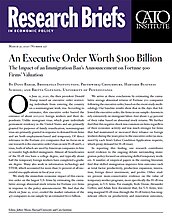We study the immediate economic impact of this executive order on the largest U.S. firms by estimating the cumulative average abnormal stock returns for Fortune 500 firms in response to the policy announcement. We find that the shock on June 22, 2020, eroded the market valuation of the 471 companies in our sample by an estimated $100 billion.
We arrive at these conclusions by estimating the cumulative average abnormal returns of Fortune 500 companies following the executive order, based on the event study methodology. Our baseline results show that in the days that followed the executive order, the firms in our sample—known to rely extensively on immigrant labor—lost about 0.45 percent of their value based on abnormal stock returns. We further find that this negative shock was common on firms regardless of their economic activity and was much stronger for firms that had maintained or increased their reliance on foreign workers during the years prior to the executive order (as measured by each firm’s Labor Condition Application requests, which proxy demand for H‑1B visas).
In reporting this finding, our research contributes novel evidence to the ongoing debate surrounding immigration policy focused on attracting skilled temporary workers. A number of empirical papers in the existing literature find that skilled immigration improves firm outcomes such as total factor productivity, production expansion, innovation, foreign direct investment, and profits. Other studies present more-conservative evidence on the value of temporary-worker programs, more specifically the H‑1B visa program, to U.S. firms. For example, Kirk Doran, Alexander Gelber, and Adam Isen document that, for U.S. firms, winning marginal H‑1B visas through the H‑1B lottery has insignificant effects on productivity and innovation outcomes, such as firms’ patenting and their use of the research and experimentation tax credit. However, they do present some evidence that securing additional H‑1B visas leads to higher firm profitability.
Our research contributes to this active debate surrounding whether, and to what extent, skilled-work visas create value for firms by examining the short-run impacts of skilled-immigration restrictions on firms’ stock market valuations. Our results support the hypothesis, first posited by William Kerr and William Lincoln, that restrictions on skilled-work visas represent a supply shock to U.S. firms. While there may be longer-run adjustments—such as offshoring—that U.S. firms can make when their access to skilled labor supply is abruptly constrained, one would also expect a short-run negative impact prior to any such adjustments, which is precisely what we document here. Furthermore, while the prior literature is focused on studying the effects of the H‑1B visa policy on firm outcomes in equilibrium, we complement the prior literature by studying the effects of a policy shock to the H‑1B visa program and how it affects market valuation of U.S. firms in the immediate term.
NOTE:
This research brief is based Dany Bahar, Prithwiraj Choudhury, and Britta Glennon, “An Executive Order Worth $100 Billion: The Impact of an Immigration Ban’s Announcement on Fortune 500 Firms’ Valuation,” October 2020, doi.org/10.3386/w27997.

